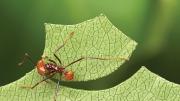Two and a half centuries ago, a young Spanish doctor named José Celestino Mutis arrived in present-day Colombia and promptly began writing hundreds of pages of groundbreaking observations about ants. He sent them in book form to the great Swedish taxonomist Carl Linnaeus, but the volume was lost at sea. “This remarkable man, working entirely on his own, was a real pioneering scientist,” says renowned biologist and ant scholar E.O. Wilson, Pellegrino University Professor emeritus and two-time winner of the Pulitzer Prize. “There was nothing for him to read on ants. He learned everything by himself from scratch.” Now Wilson, collaborating with Spanish myrmecologist José Gómez Durán, has reconstructed Mutis’s field work from rediscovered diaries and papers. In their new book, Kingdom of Ants: José Celestino Mutis and the Dawn of Natural History in the New World (Johns Hopkins), the modern scholars “essentially write Mutis’s book for him”—restoring a long-lost chapter to the annals of the history of science.
The science that, in effect, began with Mutis was unable to benefit from his lost work, and only “began seriously in the mid nineteenth century with an author named Auguste Morel, a scientist from Switzerland,” Wilson explains. “Studies really began their modern phase in the United States under the leadership of William Morton Wheeler, who was a professor at Harvard.” Wheeler’s work strongly influenced the teenage Wilson, who recalls, “When I was 16 and decided I wanted to become a myrmecologist, I memorized his book.”
The field now finds in Wilson one of its most accomplished and best-known contemporary experts. Alongside the book on Mutis, he is simultaneously releasing, with his frequent co-author and former colleague, Bert Hölldobler, a second book, The Leafcutter Ants: Civilization by Instinct (W.W. Norton), which comprehensively consolidates the scholarship on two of the most sophisticated of ant genera: Atta and Acromyrmex. As the subtitle suggests, these two species are notable not only for their practice of harvesting vegetation, but also for the complex division of labor they adopt in order to use leaves as a matrix for farming the fungi that provide their food. “These ants have the most complex social systems of all the social insects,” Wilson explains, “and that makes them the most complex socially of all animals, except for humans.”
The two books were conceived independently, but felicitously have ended up bookending a 250-year tradition within myrmecology: Mutis was the first person to record extensive observations of the leafcutter ants. “They excavate the soil, while eating all the green vegetation in the sown lands, and [carrying away the vegetation] with intelligence and speed,” he wrote in his diary sometime within five years of 1770. Wilson and Durán present the material from his notebooks on ants in English for the first time, framing it within modern research on the same organisms and behaviors that Mutis puzzled over in an age when Spain still ruled much of South America. “It’s rather extraordinary,” Wilson points out, “to be able to bracket the beginning of the study of one of the most important insects in the world some 250 years ago and then present the latest that we know about them, which is a great deal.”
He notes admiringly that Mutis’s science has proved not merely novel for its time, but also quite accurate. “For possibly one of the last times in the history of science, we see how a young scientist began working in a field where there was virtually nothing to go on or published—all he had was folklore and what he could see with his own eyes—and his book shows what it was like to be thinking as a scientist in an early era, and the sort of problems he came up against—how he made do.” Wilson also stresses that, even after the thorough treatment he and Hölldobler provide in The Leafcutter Ants, there are still many myrmecological observations to be made and problems to be solved: “I hope if you’re a young scientist who wanted to work with these ants, and you wanted to know what new areas are open and discoveries to be made, you’d still find some big gaps in this book.”












